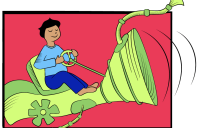By Jeremy Hodgkin, Senior Acquisition Analyst
As a Program Manager, have you noticed a trend that your program keeps on repeating the same lessons learned or mistakes? As a program, when completing a yearly reporting requirement, do you hear yourself stating to your staff that we did not complete x, y, or z in order to fulfill our operational requirements?
If you have, there is no better time than year’s end to develop and implement a continuous improvement plan into your program’s 2015 operations.
Are we talking about Kaizen, Total Quality Management, or Lean Six Sigma? None of these approaches to continuous improvement may be applicable to your program or your program manager’s style or time constraints. There are simple steps that can be taken, with very little time investment, which will allow program managers to bring continuous improvement to their program’s operations.
Good Intentions Lack Follow-Through
In the past, I have worked with state and local emergency management divisions/departments to design and conduct preparedness exercises to test their response to a natural or man-made incident. In a series of these drills, those emergency management departments would repeatedly identify the same lessons learned, whether it was developing or improving upon existing standard operating procedures, or improving internal and external communications. Sometimes I would return several months later, work with them on another drill, and find they were still scratching their heads as to how they did not improve even though they put the lessons learned into their improvement plans in their exercise after action reports.
Their problem was that they did not follow through on their identified improvements and did not implement a plan to incorporate them into their operations. Emergency managers who did however, discovered it resulted in improved response capabilities and increased efficiency within their departments.
Steps to Implement Continuous Improvement
There are simple steps a program manager can take to avoid repeating lessons learned and to improve their program’s operations. These steps require very little time commitment.
Step One: Conduct After Action Review
At the conclusion of a major programmatic activity, schedule two hours for an after action review with involved personnel. The purpose of this session is: to capture and document any best practices or lessons learned; identify standard operating procedures that need to be developed; and refine existing procedures to improve program operations. It is very important to ensure this session is truly open and encourage a session of free flowing conversation so all viewpoints are heard and discussed. Look for any applicable improvements to program operations, and simple steps to address the resolution of chronic lessons learned that are being observed over a period of time.
During this after action session, appoint someone to document all the best practices and lessons learned. At the conclusion of the meeting, review them with the group to ensure they have been captured correctly.
Step Two: Assign Responsibility
It is not enough to simply capture lessons learned and operating procedures to be created or refined. Step one is the easiest part of this process, but in order for it to have any meaning, responsibility for addressing lessons learned must be assigned. While ultimately it is the program manager’s responsibility to ensure a smooth running program, involving program staff and allowing them to take ownership of these items, will help to promote a culture of continuous improvement.
Within three days of the after action review, distribute the lessons learned to the program and ask each team member to take ownership of at least one lesson learned or task. Accepting responsibility also means putting a time goal in place to address that lesson learned, and holding those individuals accountable for achieving that time goal.
It is important to not simply assign responsibility and a time goal and put it on cruise control. The program manger should perform periodic gateway checks on progress to ensure the original time goal for addressing a lesson learned is on track, or if it is not, if more time is required for close out. These gateway checks impress upon program staff that continuous improvement is definitely a part of the program’s culture, and that it is important.
Step Three: Incorporate all Time Goals Into Program’s Integrated Master Schedule
Once all the lessons learned and actions have been assigned and time goals established, place those time goals into the program’s integrated master schedule and disseminate it throughout the entire program. This communication informs program staff, and the schedule will keep personnel accountable. For additional information on integrated master schedules, please see our post “How an Integrated Master Schedule Can Avert Program Management Disaster.”
Step Four: Close-Out & Review
Upon completion of steps one through three, when all lessons learned have been closed out and standard operating procedures have been created, it is important to test out those procedures with the next major program initiative to ensure the improvement has actually occurred and the new procedures are working. Once that is done, you will start at step one again, and hopefully the program will discover that your previous lessons learned have now become best practices. During this process, do not be discouraged if you discover new lessons learned, as program challenges are dynamic.
Continuous Improvement Enhances Program Operations
If a program manager implements a very basic continuous improvement process into a program’s operations, I believe the program will become more efficient. As a manager, you will not feel that you continue to repeat the same lessons learned, or that you’re helpless to address the issues. Not only that, with the above approach, you will achieve more program ownership amongst your team. By encouraging a culture of continuous improvement, team members will begin looking for other areas for improvement within the program and not only at critical program activities.
A few simple steps repeated throughout your program can help turn lessons learned into best practices. How do you approach continuous improvement?
See the original article and many others by visiting Integrity Matters: Perspectives on Acquisition and Program Management





Follow-through is so important. I’ve definitely been in situations where we learn the same lessons month-after-month only to never implement those lessons. Thanks for the action steps, Tracy.
Thanks for commenting Hannah. Sometimes I say when starting a new project, “Now what were those lessons we learned last time?” and then have to go back to the document to refresh my memory. Hopefully a few simple steps will take lessons learned out of the file folder and into a plan in progress.
Hi Tracey! Actually I’m also agree with Hannah’s comment. Lack of my laziness I didn’t follow or implement all the things which I learn with a long time. There is a proverb “Practice makes a man perfect” it’s really true. Thanks to you from bottom of my heart for the amazing post which attach in my heart as a reminder. 🙂 🙂 🙂